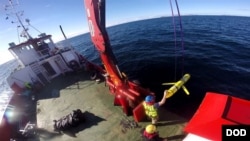Competing activities by the United States and China in the disputed South China Sea are exacerbating already strained relations between the superpowers and prompting forecasts for more serious conflicts after U.S. President-elect Donald Trump takes office next month.
The South China Sea, rich in fisheries as well as possible undersea fossil fuel reserves, is claimed in whole or in part by China, Brunei, Malaysia, Vietnam, Taiwan and the Philippines.
China claims about 95 percent of the 3.5 million-square-kilometer ocean based on historic usage records. The United States says the sea, which handles about half the world’s marine shipping traffic, must stay free for international use. But Beijing has accused Washington of trying to keep China’s power in check.
The U.S. think tank Center for Strategic and International Studies said in a report December 13 that Beijing had militarized parts of the Spratly Islands, an archipelago in the contested South China Sea.
Reaction to Trump comments?
In an unrelated incident two days later, China seized an unmanned underwater vehicle that a U.S. naval ship was using for scientific measurements in the same body of water.
The Defense Ministry in Beijing said a naval lifeboat took the drone to ensure safety for passing ships and would give it back in an “appropriate manner.” The U.S. Defense Department said Friday the drone was working with the USNS Bowditch on “routine operations” in international waters. The vehicle can be used to test salinity, water temperature and sound speed.
The Chinese Defense Ministry statement that it would return the vehicle in an “appropriate manner,” raises questions about whether it might first confiscate equipment inside the drone.
The People’s Liberation Army may remove intelligence data from the drone before returning it, a Chinese expert said Sunday.
“The Chinese actions are sort of provoking. Maybe they may want to send a signal they are not happy with the comments made by President-elect Mr. Trump,” said Andrew Yang, secretary-general with the Chinese Council of Advanced Policy Studies think tank in Taiwan.
Trump said earlier in the month he might snub Beijing’s claim to sovereignty over Taiwan, a self-ruled island. He has called Sino-U.S. trade ties unbalanced. Trump tweeted Sunday that the U.S. didn't want "the drone they stole back- let them keep it."
Chinese Foreign Ministry spokeswoman Hua Chunjing Monday objected to Trump's accusation of theft, saying the claim was "not accurate."
Reefs militarized
The Washington-based think tank Asia Maritime Transparency Initiative reported on its website that, based on its research since July, China had built “significant point-defense capabilities, in the form of large anti-aircraft guns and probable close-in weapons systems” on seven reefs it controls in the Spratly chain.
“It’s really important to understand what is their intention,” Yang said of China’s maritime expansion. “For years the United States has tried to get the idea of what is the Chinese intention there and why they want to expand their influence.”
Chinese Defense Ministry spokesman Yang Yujun told the official Xinhua News Agency Sunday that “China resolutely opposes" U.S. activities in the South China Sea, "and demands that the U.S. side should stop such activities.” Yang was quoted saying, “China will continue to be vigilant against the relevant activities on the U.S. side, and will take necessary measures in response.”
WATCH: What is the South China Sea dispute?
Expect more U.S. naval surveillance in the South China Sea, said Alexander Huang, strategic studies professor at Tamkang University in Taiwan. Beijing, for its part, does not want to “see Donald Trump inaugurated,” Huang said.
“There’s some kind of tension lingering and continuing to accumulate and it won’t go away no matter (whether) there’s a U.S. election or a different kind of leader coming into the White House,” Huang said. “The continued construction or militarization will be kind of a trending thing, so there will be some kind of trend of a slow-growing tension between China and the United States.”
China can keep up its military activities in the South China Sea at today’s levels with little disruption, analysts say.
Some believe Chinese President Xi Jinping is using the South China Sea conflicts to show strength ahead of next year’s 19th National Congress of the Communist Party, an event often paired with turnover on the powerful Politburo Standing Committee.
“We see occasional flares and demonstrations of military force in the region,” said Marie Diron, Senior VP at Moody’s Investors Service in Singapore. “Where it starts to matter is when those demonstrations are becoming increasingly frequent and upsets start having an impact on the economy or fiscal outcomes. So far that’s not our assessment for China.”








